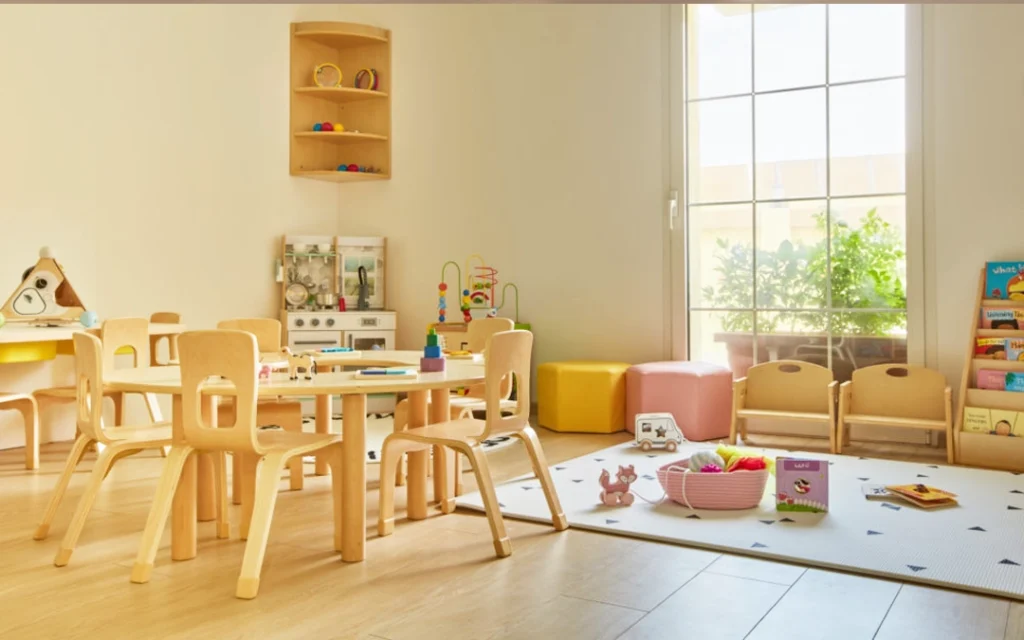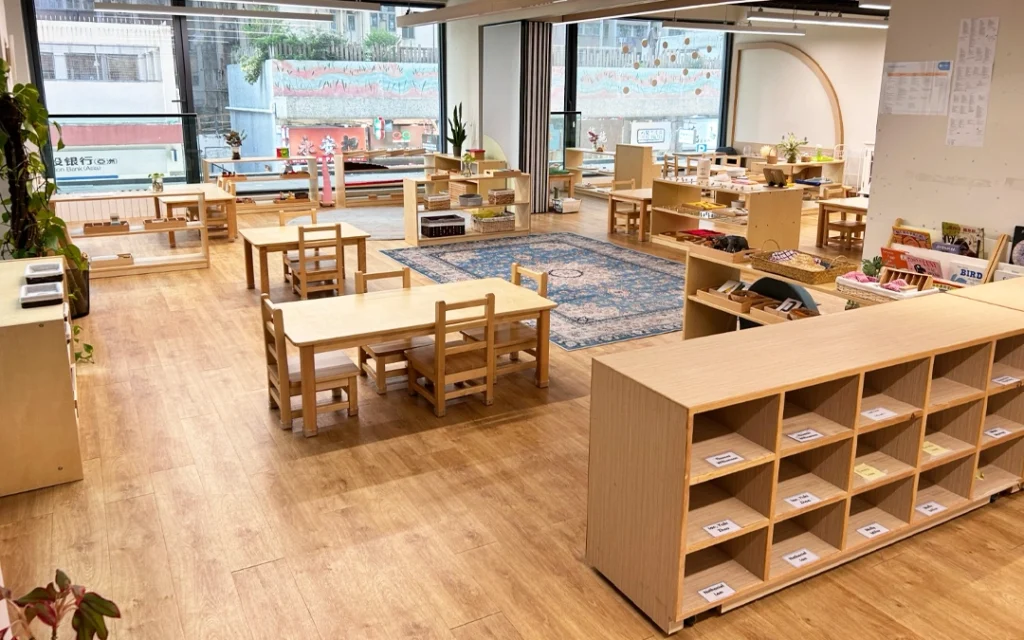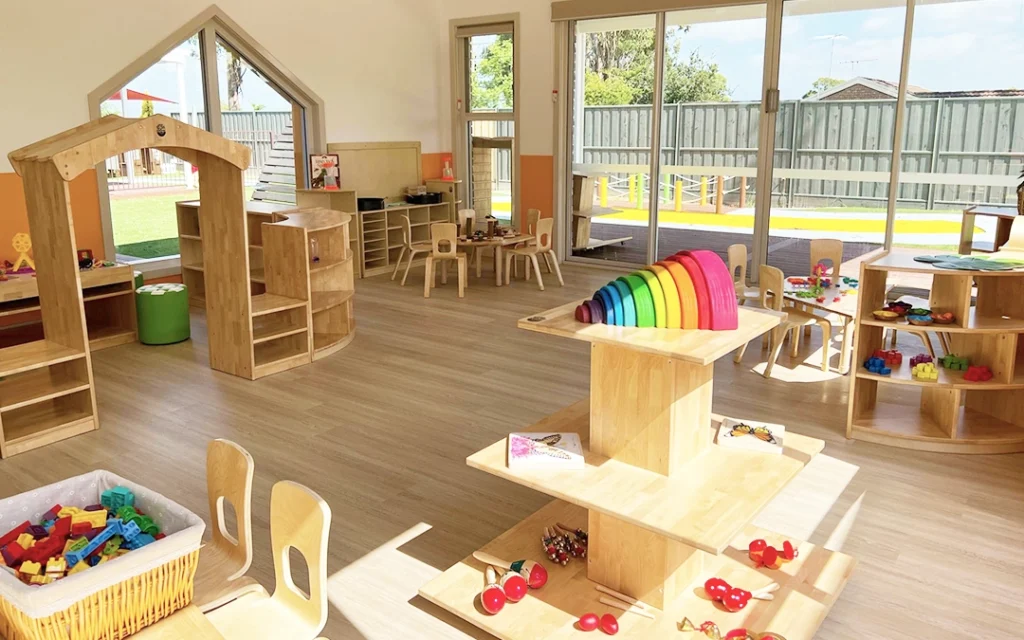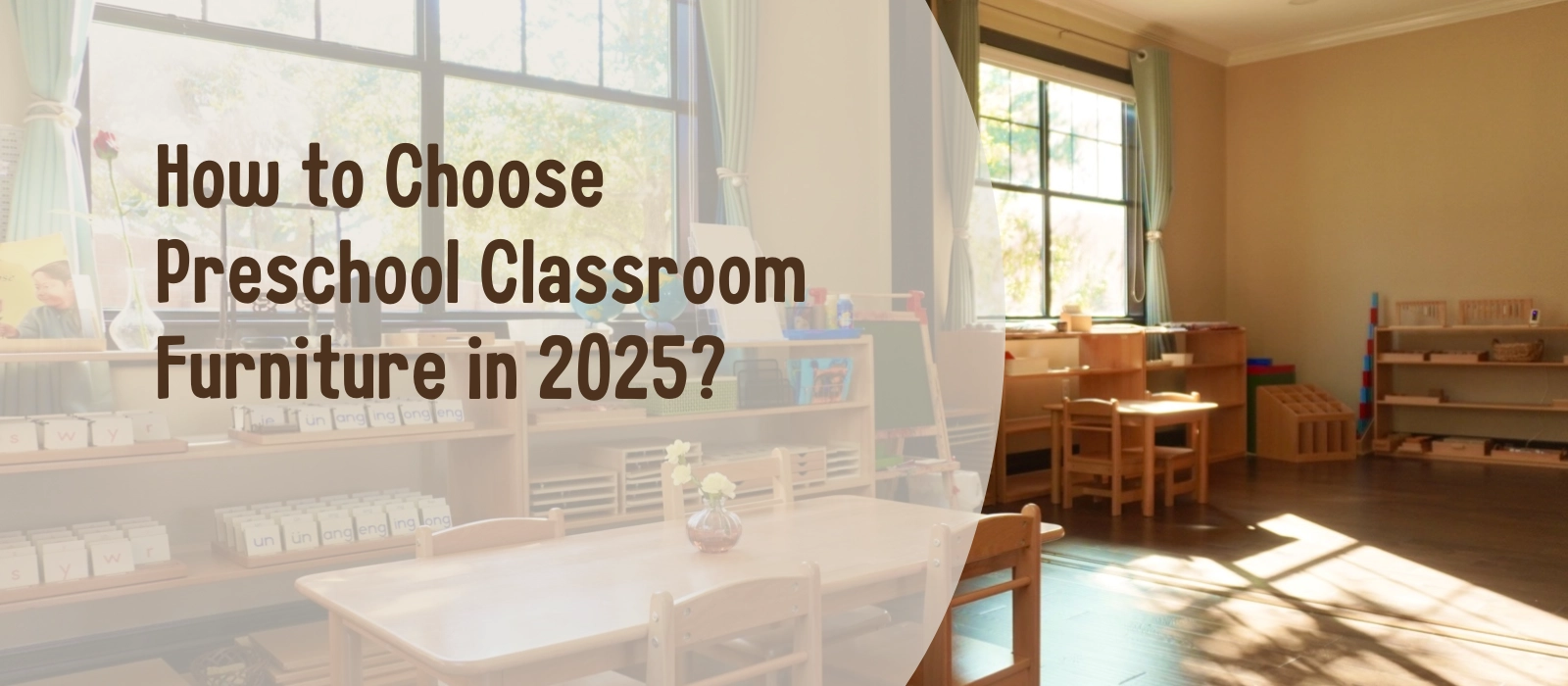Are you starting a new kindergarten or upgrading your current preschool classroom? Feeling overwhelmed by the countless furniture options? Do you worry about choosing furniture that’s not safe, not durable, or simply not right for young children? Or perhaps you’re wondering how to find the best preschool classroom furniture at a reasonable price—especially when buying in bulk from China?
Here’s the truth: Choosing preschool classroom furniture is about much more than looks. It’s about creating a functional, safe, and engaging environment that supports early childhood education and meets the real needs of both children and educators.
In this complete guide, I’ll walk you through everything you need to know to make smart, confident decisions when choosing preschool classroom furniture in 2025—whether you’re designing a new classroom or furnishing multiple locations.
What is Preschool Classroom Furniture?
Preschool classroom furniture includes the full range of furniture designed specifically for use in early education environments—typically for children aged 2 to 6 years. It encompasses child-sized tables and chairs, cubbies and storage units, reading corners, dramatic play furniture, art stations, and more. Each piece is tailored to promote safe exploration, comfortable posture, and independent learning in a group setting.

Unlike standard household furniture, preschool classroom furniture is built for durability, high-traffic use, and child-centered ergonomics. It’s designed with scaled-down dimensions to match a child’s physical development, and incorporates bright colors, smooth surfaces, and rounded edges to ensure both safety and engagement.
Functionality is also key. Good preschool classroom furniture serves multiple purposes—like combining storage and play, or encouraging collaboration and quiet focus. The best furniture setups help create structured, stimulating environments where children can thrive cognitively, socially, and emotionally.
Why Choosing the Right Preschool Classroom Furniture Matters
The furniture in a preschool classroom is more than just a backdrop—it’s a foundational tool for learning, development, and safety. Every piece of preschool classroom furniture contributes to the day-to-day experience of both students and teachers.

Supports Child Independence and Engagement
From a child’s perspective, well-designed furniture encourages independence, comfort, and a sense of ownership over their space. Appropriately sized tables and chairs let children sit with good posture, stay focused longer, and feel physically secure. Open storage allows them to make choices, build responsibility, and interact confidently with their learning environment.
Enhances Teaching and Classroom Management
For educators, the right preschool classroom furniture supports smooth transitions, clear routines, and efficient organization. Teachers benefit from furniture that’s easy to clean, modular to rearrange, and supportive of varied learning activities—whether it’s group time, quiet reading, hands-on play, or individual instruction.
Influences Parent Perception and School Reputation
On a broader level, classroom furniture reflects your school’s values and professionalism. Parents who visit will judge the learning space in an instant. A bright, clean, and functional classroom gives them confidence that their children are in a safe, enriching environment. On the other hand, outdated or unsafe furniture can raise red flags—even if your teaching is excellent.
Saves Money Over Time
There’s also a financial perspective to consider. Low-quality furniture may seem cost-effective at first, but replacements, repairs, and even liability from accidents can add up. Investing in high-quality preschool classroom furniture saves money over time and enhances your brand’s reputation for excellence.
In essence, furniture choices affect everything: how children learn, how teachers teach, and how your kindergarten is perceived by families and regulators alike. That’s why choosing the right preschool classroom furniture is not a minor decision—it’s a strategic investment in your school’s success.
Types of Preschool Classroom Furniture and Their Functions
Understanding the various types of preschool classroom furniture helps educators and decision-makers select pieces that serve both functional and developmental purposes. Here’s a breakdown of the most essential categories:

1. Tables and Chairs
These are the backbone of every preschool classroom. Designed with age-appropriate dimensions, preschool tables and chairs support group learning, individual tasks, and social interaction. Choose rounded edges for safety and adjustable heights for flexibility as children grow. Materials like solid wood or durable plastic are commonly used to ensure safety and longevity.
2. Storage Units and Cubbies
Preschool classrooms generate a lot of materials—books, toys, art supplies, learning aids. Storage furniture like cubbies and open shelves encourages children to take responsibility for their belongings, promotes organizational habits, and helps keep the room tidy. Opt for open designs with labels to promote accessibility and learning.
3. Dramatic Play Furniture
This includes miniature kitchens, market stands, puppet theaters, and costume racks. Dramatic play furniture nurtures creativity, emotional development, and social learning as children engage in role-play and imagination-based activities. High-quality, sturdy construction is important to ensure both safety and durability under frequent use.
4. Reading Corners and Soft Seating
Comfortable reading nooks with bean bags, child-sized couches, and low bookshelves foster a love of reading and provide quiet spaces for reflection or decompression. Soft seating also adds warmth and comfort to the classroom environment. Choose washable fabrics and low-VOC materials for safety.
5. Art and Sensory Stations
These include easels, art tables, and water/sand tables. Art stations inspire creativity and self-expression, while sensory stations stimulate cognitive and motor development through tactile play. Ensure that surfaces are water-resistant and easy to clean, with storage options for supplies.
6. Nap Mats and Sleeping Furniture
Especially important in preschool settings with toddlers, stackable cots or nap mats offer a hygienic and comfortable rest solution. They should be easy to clean, lightweight to move, and stackable to save space. Look for non-slip bottoms and breathable materials.
7. Outdoor Preschool Furniture
Where space allows, outdoor furniture such as weather-resistant benches, picnic tables, and garden activity tables expand learning into nature. They support physical activity, nature exploration, and group activities in fresh air. Prioritize UV-resistant and rust-proof materials to ensure longevity.
Every category of preschool classroom furniture plays a role in creating a well-rounded, engaging learning environment tailored to early childhood needs. With careful planning and sourcing, your classroom can become a space where both safety and creativity thrive.
How to Choose Safe and Durable Preschool Classroom Furniture
When selecting preschool classroom furniture, safety and durability should be your top priorities. Here’s a detailed guide broken down into key decision areas:

1. Materials and Safety Standards
Start by checking the materials. Choose furniture made from non-toxic, BPA-free plastic, solid wood with child-safe finishes, or certified engineered wood. Look for furniture that complies with international safety standards such as EN71, ASTM F963, or ISO 8124. These certifications ensure the furniture is free from hazardous substances and safe for young children.
2. Structural Design and Stability
Furniture used in preschool classrooms should be stable and tip-resistant. Prioritize designs with a low center of gravity, wide leg bases, and anti-tip mechanisms. Avoid lightweight furniture that moves or flips easily. All edges should be smooth and rounded to reduce the risk of injury.
3. Certifications to Look For
In addition to material certifications, ensure the manufacturer provides relevant documentation for product safety and compliance. For international buyers, ask for export-specific certificates such as CE (Europe), SGS, or TUV reports. These guarantee that the furniture meets regulatory standards for your target market.
4. Maintenance and Cleanability
Preschool environments are prone to spills, scratches, and stains. Select surfaces that are waterproof, scratch-resistant, and easy to disinfect. Materials like laminated plywood, ABS plastic, or coated metal work well. Avoid fabrics or finishes that trap dirt or require complex cleaning procedures.
5. Ergonomics and Child Comfort
Proper ergonomics ensure children can sit and work comfortably for extended periods. Tables and chairs should be matched to child height, or adjustable where possible. Seating should promote upright posture without restricting movement. Rounded seats, lumbar support, and foot contact with the floor are good indicators of ergonomic design.
6. Longevity and Cost Efficiency
Durable preschool classroom furniture may cost more upfront but will save you money over time. Look for features like reinforced joints, rust-resistant components, and replaceable parts. Choose manufacturers that offer warranties or quality guarantees. Remember, replacing cheap furniture frequently costs more than investing in well-made pieces once.
By paying close attention to these six aspects, you’ll ensure the preschool classroom furniture you choose is not only child-friendly but also a smart long-term investment for your kindergarten.
Why Buy Preschool Classroom Furniture from China?
China has become the go-to source for preschool classroom furniture among international kindergarten owners, school chains, and educational organizations—and for good reason. From pricing to production capacity, the advantages are significant and well-documented.
1. Competitive Pricing
Chinese manufacturers offer factory-direct pricing thanks to mature supply chains, economies of scale, and advanced production automation. According to Statista, China’s average manufacturing labor cost is approximately $6.50/hour, compared to $30–$40/hour in the U.S. or Europe. This cost difference directly lowers your per-unit furniture price.
2. Massive Production Capacity
China has the largest furniture production base in the world. In 2024 alone, China exported over $58 billion worth of furniture, according to UN Comtrade. This capacity enables short lead times, fast turnarounds, and the ability to fulfill large volume orders without delays—perfect for multi-classroom or multi-location projects.
3. Customization and OEM Flexibility
Unlike many Western manufacturers, Chinese factories are built to be flexible. Whether you want your logo printed, special color matching, or a fully custom-designed preschool set, it’s all feasible. Suppliers like XIHA offer OEM and ODM services tailored to international customer needs.
4. Access to Certified Quality
Reputable Chinese factories produce furniture that complies with international standards such as EN71 (Europe), ASTM F963 (USA), ISO9001, and FSC. In fact, many large European and North American furniture brands outsource production to China, proof that quality can meet global benchmarks when working with the right supplier.
5. Logistics Ecosystem and Export Expertise
China’s logistics and freight forwarding ecosystem is unmatched. Ports like Shenzhen, Ningbo, and Shanghai are among the busiest in the world. As a result, many Chinese suppliers—including XIHA—can offer complete logistics support from factory floor to your front door, including DDP delivery.
6. Proven Track Record in Educational Supply
Tens of thousands of international kindergartens already source their preschool classroom furniture from China. From Montessori centers in Canada to early childhood chains in Australia and the Middle East, Chinese-made classroom furniture is helping schools grow while reducing capital expenditure.
7. Digital Accessibility and Global Platforms
Thanks to platforms like Alibaba, Made-in-China, and Canton Fair’s digital trade showrooms, buyers can now easily access verified suppliers, view certifications, and compare offers—all without visiting in person.
Comparative Table: Advantages of Buying Preschool Classroom Furniture from China
| Factor | China | U.S./Europe |
|---|---|---|
| Average Labor Cost | ~$6.50/hour (Statista) | $30–$40/hour |
| Production Capacity | World’s largest furniture exporter | Limited volume, longer lead times |
| Customization Flexibility | High (OEM/ODM support widely available) | Moderate to Low |
| Certifications Available | EN71, ASTM, ISO9001, FSC | EN71, ASTM, ISO9001, FSC |
| Pricing | 30%–60% lower on average | High due to labor and overhead |
| Logistics Infrastructure | Top global ports + DDP shipping available | Regional ports, limited DDP options |
| Sourcing Platforms | Alibaba, Made-in-China, Canton Fair | Few centralized wholesale platforms |
| Track Record | Tens of thousands of global kindergartens served | Mostly local/regional institutions |
If you’re serious about scaling your kindergarten operation efficiently, buying preschool classroom furniture from China isn’t just an option—it’s the smart strategic choice backed by data, infrastructure, and decades of manufacturing evolution.
Tips for Buying Preschool Classroom Furniture in Bulk from China
Buying preschool classroom furniture in bulk from China can offer substantial cost savings and access to a wide variety of designs—but only if you navigate the process correctly. Here are key tips, organized by step, to ensure a smooth and successful procurement experience:

1. Work Directly with a Manufacturer, Not a Trader
To get the best prices and consistent quality, always try to work directly with a preschool furniture manufacturer rather than a trading company. Factories like XIHA Furniture offer transparency, better customization options, and faster communication. You’ll also avoid extra markups and potential delays.
2. Request Samples Before Bulk Orders
Before committing to a large shipment, always ask for a sample of the preschool classroom furniture you plan to purchase. This allows you to verify quality, dimensions, finish, and functionality. It’s a small upfront cost that can save you thousands by avoiding surprises in the final order.
3. Confirm Certifications and Compliance Documents
When importing furniture for use in educational environments, especially in North America or Europe, certification matters. Make sure the supplier can provide CE, EN71, ASTM, or ISO documents. This not only protects children but also helps your business pass regulatory checks without hassle.
4. Clarify Production and Lead Times in Writing
Delays in production or delivery can be costly—especially if you’re furnishing a classroom before the school term starts. Clarify lead times for production and shipping in your contract. Typical production times range from 25–45 days, depending on order size and season.
5. Choose the Right Shipping and Logistics Option
Most buyers choose sea freight (FCL or LCL) for cost efficiency. Work with a freight forwarder or ask your supplier if they offer DDP (Delivered Duty Paid) options. Make sure all Incoterms (FOB, CIF, EXW) are clear to avoid unexpected logistics fees.
6. Negotiate Payment Terms Safely
Standard payment terms include 30% deposit + 70% before shipping. For large orders, consider using a Letter of Credit (L/C) for extra protection. Be cautious with 100% upfront payments unless you’ve built long-term trust with the factory.
7. Consider Packaging and Damage Prevention
Ask about packaging standards, especially for international shipping. Furniture should be packed with corner protectors, thick cartons, and waterproof layers. Well-packed items reduce the risk of damage during long transits and avoid costly replacements.
8. Communicate Regularly and Ask for Production Updates
Maintain ongoing communication with your supplier. Ask for photos or videos during production. This gives you peace of mind, allows you to catch any misunderstandings early, and keeps the project on track.
9. Plan for Customs, Duties, and Local Delivery
Include customs clearance and last-mile delivery in your planning. If you’re unfamiliar with import processes, a logistics partner or DDP arrangement with your supplier can simplify things. Budget for customs duties, VAT, or inland transportation fees.
10. Build a Long-Term Relationship
If you’re planning to open more classrooms or operate multiple kindergartens, building a long-term partnership with a reliable Chinese manufacturer like XIHA can give you better pricing, priority production slots, and trusted after-sales support.
XIHA Furniture: Your One-Stop Preschool Furniture Supplier
At XIHA Furniture, we’ve been manufacturing and exporting high-quality preschool furniture for over a decade. As a factory with five production lines, we combine cost control with flexible production capabilities.
We serve clients across North America, Europe, and Australia, with a strong presence on platforms like Alibaba and through international trade shows. Our main offerings include:
- Preschool tables and chairs
- Bookshelves and cubbies
- Role-play and dramatic play sets
- Sensory tables and learning stations
- Soft seating and reading corners
Why choose us?
- Competitive factory prices
- International certifications (EN71, ISO9001)
- Custom design and OEM service
- Logistics support for international clients
- On-time delivery and secure packaging
Our goal is simple: to help you build a safe, functional, and beautiful learning environment at the best value.
Conclusion
Choosing the right preschool classroom furniture impacts everything—from child development and teacher effectiveness to parent trust and long-term cost savings. With thoughtful planning and a reliable supplier like XIHA Furniture, you can build a high-quality learning space that stands the test of time.
Whether you’re furnishing a single classroom or scaling multiple kindergartens, make smart choices now, and your students—and business—will thank you later.



